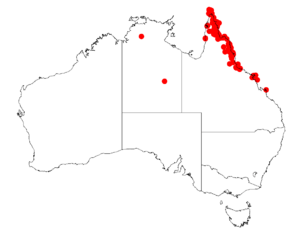Acacia polystachya facts for kids
Quick facts for kids Acacia polystachya |
|
|---|---|
| Scientific classification | |
| Genus: |
Acacia
|
| Species: |
polystachya
|
 |
|
| Occurrence data from AVH | |
Acacia polystachya is a type of tree found in the northeastern parts of Australia. It belongs to the large group of plants called Acacia, which are often known as wattles. This tree is special because it's native to this specific area of Australia.
What it Looks Like
This tree can grow quite tall, usually between 3 and 25 meters (about 10 to 82 feet) high. Its bark is dark brown to grey and can be smooth or have ridges. The younger branches are often smooth, grey, brown, or purplish.
Instead of typical leaves, Acacia polystachya has what are called phyllodes. These are flattened leaf stalks that act like leaves. They are usually long and narrow, sometimes a bit curved like a sickle. These phyllodes are smooth and thin, measuring about 7.5 to 25 centimeters (3 to 10 inches) long and 1 to 3.2 centimeters (0.4 to 1.3 inches) wide. They have two or three main veins that stand out.
The tree blooms with yellow flowers between April and July. These flowers grow in spikes that are about 3.5 to 7.5 centimeters (1.4 to 3 inches) long. The flowers are light yellow and are not packed too tightly together on the spikes.
After the flowers, the tree produces seed pods. These pods are thin, blackish, and shaped like a line. They can be straight or slightly squeezed in between the seeds. Sometimes, they are even strongly curved or twisted! The pods are covered in a powdery white coating and are smooth. They are about 8.3 to 13 centimeters (3.3 to 5.1 inches) long and 6 to 10 millimeters (0.2 to 0.4 inches) wide. Inside, the seeds are black, slightly bumpy, and round. They are about 3.5 to 4.2 millimeters (0.14 to 0.17 inches) long and have a yellow thread-like structure called a funicle wrapped around them.
How it was Named
The first official description of Acacia polystachya was made by a botanist named Allan Cunningham in 1842. His work was published in a journal called London Journal of Botany.
Later, in 1987, another botanist named Leslie Pedley changed its name to Racosperma polystachyum. However, in 2001, it was moved back to the Acacia group, which is where it remains today.
Where it Lives
This tree is endemic to certain parts of far north and northern Queensland in Australia. This means it naturally grows only in this specific region and nowhere else in the world.
You can find Acacia polystachya along the east coast of Queensland. Its northern range goes as far as Banks Island in the Torres Strait. It also grows along the eastern side of the Cape York Peninsula and down to areas around Cairns. It has even been spotted on Palm Island.
These trees often grow near beaches, creeks, and rivers. They prefer to grow in rich, fertile soil that has been deposited by water, which is called alluvial soil. They are often part of dense plant communities known as vine thickets.

